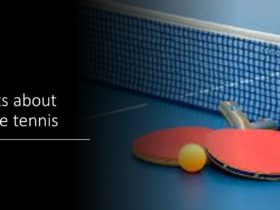1. The Drive: It is a light topspin stroke that produces a low-ball trajectory, are the primary offensive strokes in table tennis. There are two types of drives forehand and backhand. The mastery of both the forehand and backhand drives is important because it will give your opponent less options when using attacking strokes of his/her own. In executing this and all other offensive strokes, the usage of the entire body in unison is important for consistency and power. Keep in the ready position until you are ready to execute the shot and remain relaxed but responsive (this is very important).
- Forehand Drive: Keep the upper arm close, but not flush, to the torso. The forearm (form a rough 90-degree bend with the upper arm) should be drawn back to the 3 o ‘clock position, and let the waist turn naturally along with the arm (this is where relaxing is important). Shift your weight toward the right foot at the same time. While shifting your weight back to your left foot, swing forward with a slight upward motion, with the waist providing additional force in the swing. Use the elbow as a pivot point. It should not move so much up and down, but also should be allowed to move slightly forward in the follow-through. Contact with the ball should be made slightly to the side of the body after the top of the bounce. Make sure the paddle is somewhat closed (or facing downwards at an angle) and remains that way throughout the stroke. Follow- through should finish when racket is parallel with the left shoulder. Immediately return to the ready position. The left foot should be slightly in front of the right for support.
- Backhand Drive: From the ready position, the waist turns left with the racket pointing towards the 9 o’clock position. When following through, contact with the ball is made in front of the body, slightly after the top of the bounce. Let the elbow again act as the pivot point and snap the forearm forward in a slightly upward direction. Make sure the paddle is closed. Follow-through should finish naturally (about 12~1 o ‘clock) after contact with ball. The left foot should be slightly ahead of the right.
2. The Push: Pushes are the basic backspin shots, used to change the pace of an exchange or to return certain very low and close shots such as backspin serves. A generally defensive shot, it allows placement anywhere on the table that is difficult to attack when executed properly. All pushes should be done with the right foot stepping in. The ball is contacted right after the bounce with an open racket. How open the racket is depending on the intensity of backspin on the ball. Heavier backspin requires a more open racket to return over the net. Try to keep the ball low, varying the amount of backspin and racket angle.
- Forehand Push: Bring the racket slightly up and back, while keeping the elbow at your waist. Bend the wrist back. Swing forward with a downward motion, and when the racket reaches the ball snap the wrist forward for extra racket speed. With an open racket, graze the bottom half of the ball. An ideal contact point is right after the ball bounces. Never push a ball at the top of the bounce, because the resulting return will pop the ball high enough for the opponent to execute a smash. Try to hit the ball in front and slightly to the right of your body. Follow through forward and slightly down and return to the ready position.
- Backhand Push: Bring the racket slightly up and back, close into your stomach while cocking the wrist back. This time try to contact the ball directly in front of your body, and remember to keep the elbow still while the forearm and wrist move forward and down. Graze the bottom of the ball and follow through.
3. Block: Blocking allows a player to use the opponents force against him/her, and is done immediately after the bounce so that maximum control and speed are retained. Adjusting the racket angle depends on the severity of topspin on the ball; the more topspin there is, the more you should close the racket. Being essentially a cut-down drive, there is very little backswing and follow-through.
4. The Smash: The smash, or kill, is the put-away stroke of table tennis. Any ball that is high enough and close enough to the opponents side can be smashed, although some opportunities are better than others. Smashing combines waist, forearm, and wrist movement to the fullest extent. A good smash is very hard to return, but it can be done. Do not dawdle after you have executed a smash. The ball is contacted at the top of the bounce at its highest point.
- Forehand Smash: Similar to the drive, the key differences include: A longer back swing Greater weight transfer during swing Faster, more intense snapping of the forearm when contacting ball Depending on ball height and position, the racket is closed more than usual to keep the ball in the court Longer follow-through, but don’t forget to anticipate a possible return!
- Backhand Smash: Again, use the guidelines above and apply them to the backhand drive. Be sure to snap the wrist more as you contact the ball and finish in a long follow-through.



Leave a Reply